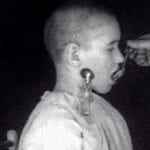 Weird Stuff
Weird Stuff  Weird Stuff
Weird Stuff  Our World
Our World 10 Ways Your Christmas Tree Is More Lit Than You Think
 Movies and TV
Movies and TV The 10 Coolest Stars to Set Sail on The Love Boat
 History
History 10 Things You Didn’t Know About the American National Anthem
 Technology
Technology Top 10 Everyday Tech Buzzwords That Hide a Darker Past
 Humans
Humans 10 Everyday Human Behaviors That Are Actually Survival Instincts
 Animals
Animals 10 Animals That Humiliated and Harmed Historical Leaders
 History
History 10 Most Influential Protests in Modern History
 Creepy
Creepy 10 More Representations of Death from Myth, Legend, and Folktale
 Technology
Technology 10 Scientific Breakthroughs of 2025 That’ll Change Everything
 Weird Stuff
Weird Stuff Ten Bizarre Facts About The Doge Meme
 Our World
Our World 10 Ways Your Christmas Tree Is More Lit Than You Think
 Movies and TV
Movies and TV The 10 Coolest Stars to Set Sail on The Love Boat
Who's Behind Listverse?

Jamie Frater
Head Editor
Jamie founded Listverse due to an insatiable desire to share fascinating, obscure, and bizarre facts. He has been a guest speaker on numerous national radio and television stations and is a five time published author.
More About Us History
History 10 Things You Didn’t Know About the American National Anthem
 Technology
Technology Top 10 Everyday Tech Buzzwords That Hide a Darker Past
 Humans
Humans 10 Everyday Human Behaviors That Are Actually Survival Instincts
 Animals
Animals 10 Animals That Humiliated and Harmed Historical Leaders
 History
History 10 Most Influential Protests in Modern History
 Creepy
Creepy 10 More Representations of Death from Myth, Legend, and Folktale
 Technology
Technology 10 Scientific Breakthroughs of 2025 That’ll Change Everything
10 Creepy And Improbable Horror Movie Plots That Actually Happened
We’ve already discussed the real-life origins of horror movie plots. But what may be even creepier are real-life events that mirrored these improbable plots long after they’d become a part of our cultural lore.
10 Skinny-Dipping With A Corpse
Swimming at night is a cliche that’s been used in horror flicks since at least 1957 when The Monster That Challenged the World snacked on a sailor and his girl while taking a midnight swim. When you subtract swimsuits, you also add a bit of vulnerability (and titillation) to create genuine tension. Steven Spielberg used it in the opening sequence of Jaws (1975), and Joe Dante used it in Piranha (1978). Later, it was used repeatedly in the Friday the 13th franchise.
A variation of this plot device is to let the skinny-dippers live but have them playfully romp, unaware that they share the water with a decomposing corpse. For instance, the forgettable slasher flick House of Death (1982) opens with a couple who’ve been murdered and thrown into a river. Their bodies are periodically shown floating downstream. Inevitably, a buxom woman decides to skinny-dip in the river by herself, and her swim is interrupted when the rotting cadavers surface.
Unfortunately, this happened in real life in 2011. One Sunday in June, a 37-year-old woman was swimming with a neighbor’s nine-year-old child in a Boston public pool. Both scooted down a slide into a section of the pool that was 4 meters (12 ft) deep. The boy surfaced, but the woman did not. The boy notified two lifeguards that his friend was in trouble, but neither helped.
The pool water was so cloudy that her body remained undiscovered at the bottom of the pool for two days. During that time, the pool was open, and an undisclosed number of people swam its waters, unaware of what lay under the surface. On Tuesday night of that week, some teenagers broke into the pool, allegedly to skinny-dip. They discovered the pool’s grisly secret and called the police. One spokesperson for the American Lifeguard Association said that he was aware of at least two similar incidents where bodies went unnoticed in public pools.
9 Surgeon Deliberately Mangled Patients
Doctors have been deliberately mutilating their patients on the silver screen for a century. In the 1908 French horror film The Doctor’s Experiment (aka Reversing Darwin’s Theory), a doctor injects his patients with monkey-gland serum that turns them into apes. More recently, Dr. Giggles (1992) and his dad cut out hearts in a bizarre effort to bring back his mom. Then there’s Marathon Man (1974) where Dr. Christian Szell took evil dentistry to a new level.
In real life, Dr. Glen Tucker, a prominent Wisconsin plastic surgeon, inflicted horrors on his patients. In 1978, a woman went under Tucker’s scalpel to repair a broken nose. When she awoke to severe pain in her nasal cavity, Tucker convinced her to have a second surgery. This time, she woke to find herself in an operating room devoid of nurses and anesthesiologists. Only Tucker was present, and he was brutally ripping out her stitches with his hands. She would later find gauze left inside her nose, festering with infection. Her nasal cartilage was so mangled that her nose later collapsed.
Another of Tucker’s patients with spasms in his left arm had surgery to repair it. The patient lost the use of his arm and later had to have his arm amputated. Still another patient wanted Tucker to augment her breasts. Three surgeries later, the woman’s breasts were infected and painful. During one office visit, Tucker plunged a needle into her breast without anesthesia. At another visit, he ripped a part of her implant out, again without pain meds. After yet another surgery, the woman found one breast shaped like a square and scars on both breasts so prominent that they looked like the stitching on a football.
By 1982, Tucker faced 13 malpractice suits. He faked his death in a canoe accident but was later discovered living in Florida when his wife packed up and joined him there. By then, Tucker’s insurance company had paid out over $1 million in damages. Tucker was never arrested, but in 2011, he killed himself, his wife, and their cat, Luther.
8 Expecting To Touch Pet But Touches Intruder Instead
The parents of 12-year-old Amanda left her in the care of older sister, Katherine, who departed to meet her boyfriend. Alone in the house with her dog, Odin, Amanda made the mistake of telling her chat room friend Jennifer about her predicament. Jennifer, however, was actually an adult man with crazy eyes.
The psycho stalked Amanda in her backyard and house. But Amanda had faithful Odin close by, lying under her bed and giving the girl’s hand an encouraging lick periodically. Later, when Amanda awoke to noises downstairs, she investigated and found nothing. Returning to her bed, she reached her hand down for Odin to lick. Sure enough, her hand was slathered with saliva. But as she looked up into the mirror, she saw the words “People Can Lick Too” scrawled across it. Then she saw in the mirror that it wasn’t Odin but the psycho licking her hand. Poor Odin was dead.
Such is the second story in the horror anthology movie Campfire Tales (1997). Based on an old urban legend, the fictional dog/human licking story has been told around many campfires and on many websites. In March 2015, the story became true.
An unidentified, 61-year-old hairdresser living in Palm Springs, Florida, was so busy searching her home for her two cats that she didn’t hear the knock on her front door. Her search led to her bedroom, where she was certain she’d find her felines under her bed. But when she shoved her hand under her bed, she didn’t find soft, fluffy fur. She touched cold, clammy skin.
A moment later, a strange man rolled out from under the bed and ran out of the house. He was later caught and identified as 25-year-old Christian Vatovec, a small-time burglar who had been making the rounds through the neighborhood. Vatovec had knocked on the woman’s door, and when she didn’t answer, he broke in through the back door. He had already nabbed a gold ankle bracelet and a digital camera when the woman’s wanderings forced him to seek refuge under her bed. It’s safe to say that they were both shocked when the woman searched under the bed for Whiskers.
7 Bloody Mary In The Mirror
For decades, this summoning ritual has been a favorite at girls’ slumber parties. Usually, it’s performed in bathrooms with large mirrors and almost always with candles as the only source of light. The summoner stands in front of the mirror and chants “Blood Mary” 13 times. Then a deformed face appears in the mirror, usually followed by some misfortune. For the chant, “Bloody Mary” may be replaced with “Mary Worth,” “Black Agnes,” or “Hell Satan.”
This urban legend was so popular that it was featured in movies such as Beetlejuice (1988), Bloody Mary (2006), and the Candyman franchise. However, there is nothing particularly sinister about the ritual. It’s based on an optical illusion known as the “Caputo effect” or “perceptual fading.”
Italian scientist Giovanni Caputo tested 50 volunteers by having them gaze at a large mirror in dim lighting for 10 minutes. After only a minute, most of them saw a strange, “otherworldly” face. About 66 percent of the participants saw a distortion of their own face. Another 18 percent saw the faces of animals, such as pigs, lions, and cats. Some saw complete strangers, such as a child or an old woman. Around 10 percent saw the face of a dead parent. And nearly half of the participants described the images they saw as “fantastical or monstrous beings.”
With the Caputo effect, neurons in the eye reduce or stop their signals when stimulation is unchanged, resulting in all or a portion of the person’s reflection disappearing until the eye blinks or moves involuntarily. Neurologically, the image is refreshed but not completely. So the mind fills in the image according to our expectations or experiences. If we expect Bloody Mary or the Devil, guess who suddenly appears?
6 Phone Calls From The Dead
In the episode “Long Distance Call” from the original Twilight Zone series (1959–64), Grandma gave little Billy a toy phone just before she died. After the funeral, Billy started talking to Grandma on the toy. Soon his parents realized that Grandma wanted Billy to kill himself so that he could be with her.
In A Nightmare on Elm Street (1984), the deceased Freddy taunted one of his victims using the phone. The dead also called people in Ghost in the Machine (1993), 1408 (2007), A Dead Calling (2006), and The Mothman Prophesies (2002).
In the real world, phone calls from the grave seem to come from relatives, not malevolent specters. In 2008, Chuck Peck was a passenger on a Metrolink commuter train that collided with a freight train in California’s San Fernando Valley. Of the 228 people on both vehicles, 25 died, and 135 were injured.
Five hours later, Peck’s cell phone called his son, fiancee, brother, stepmother, and sister—a series of 35 calls over a six-hour period. But there was only static on the line. When family members dialed back, the line went straight to voice mail. Later, they learned that Peck had died instantly in the crash, before his phone began its calling spree. The phone was never recovered.
In 1988, horror author Dean Koontz received a call on his unlisted number from his mom. But she had been dead for 20 years. Koontz heard his mother’s voice pleading, “Please be careful!” The woman repeated her warning three more times, and then the line went dead.
Two days later, Koontz got a call from the facility that housed his father, Ray. Dad had punched another resident. When Koontz arrived at the facility, he was shocked to see his father try to slash him with a fishing knife. Koontz wrestled the knife from Ray.
When Koontz stepped out of the room, he was greeted by cops, guns drawn. “Drop the knife!” they shouted. Koontz tried to explain, but the police shouted their warning again. He would later say, “All of a sudden, I realized that they were going to shoot me if I didn’t drop the knife. They thought I was the perpetrator. So I dropped it. [ . . . ] My own stupidity almost got me killed.” That’s when he remembered his mother’s warning.
5 Incredibly Complicated Killing Devices
In the climax to the The Pit and the Pendulum (1961), Francis Bernard (John Kerr) is strapped to a stone slab under a pendulum with an axe-like blade on the end. An elaborate system of cogs and wheels starts the pendulum swinging, and it descends closer and closer to Bernard’s torso.
The entire Saw franchise is also powered by elaborate killing devices. In Saw IV (2007), two police detectives are placed on a seesaw. At one end, Detective Matthews is standing on a melting ice block with a chain noose around his neck. At the other end, Detective Hoffman is chained to a chair, electrodes bound to his feet. If Matthews falls off or the block melts away, he will choke to death, and the seesaw will tip, sending water down the incline to electrocute Hoffman.
We’ve already talked about Boyd Taylor’s suicide by guillotine, but it’s worth noting how elaborate his contraption was. Boyd was a 36-year-old construction worker in Northumberland, England, who lived and worked with his father, Robert. In October 2002, Boyd asked to take a break from work until after Christmas. During these three months, he secretly built a guillotine over his bed.
In a wooden frame 2.5 meters (8 ft) high, Boyd mounted a blade, which was weighted with a paving stone. The stone was wired to plywood anchored into a block of wood at the foot of his bed. An electric jigsaw was positioned against the wooden block. The jigsaw was powered by a timer that could be turned on with a wall switch. The jigsaw would cut the wood, release the wire, and bring the blade down on Boyd’s head as he lay on the mattress. He also set up a contraption to automatically turn off the power so he wouldn’t be found immediately.
On January 8, 2003, Boyd took a dozen sleeping pills, flipped on the wall switch, and went to sleep on the inflatable mattress. Sometime in the middle of the night, the timer went off, and Boyd’s head was severed. As planned, the power to the saw turned off automatically.
At least 12 hours later, his father found Boyd’s body. There was no suicide note, so Robert could only speculate that his son was still depressed over the divorce of his parents 21 years earlier.
4 Critters In Our Heads
Nothing will give movie audiences the willies faster than seeing creatures gnawing on humans, especially if they’re munching north of the shoulders. In the movie The Mummy (1999), one character has a scarab burrow under his skin and then crawl all the way up his leg and torso to enter his head. In Infested (2002), mutated flies attack five people at a beach house. The flies eat their way through the human brains to control these people.
Reality is even more disturbing. Nature provides all kinds of creatures who use our melons as condos. Cockroaches love warm, moist places and may take up residence inside the mucous membranes and ears of people with poor sanitary habits. In August 2015, an Ohio couple was jailed for child endangerment and neglect after a dead cockroach was found in the ventilation tube of their four-year-old with cystic fibrosis.
Flies have also been known to use human ears as a nursery. In November 2014, a doctor posted a video in which he removed hundreds of maggots from a man’s ear canal. While rare, maggot infestations of the ear mostly happen with children under 10 and adults with mental disabilities. One 92-year-old woman with Alzheimer’s had 57 maggots removed from her ear. Ticks, crickets, bedbugs, and spiders have also been removed from ear canals.
Then there are creatures that actually eat brains. Naegleria fowleri is a parasitic amoeba that inhabits freshwater lakes and ponds. They also like to swim up a person’s nose and crawl into the human brain, where they begin eating. This causes an infection known as primary amoebic meningoencephalitis that usually kills the host within three to seven days. While rare, it does take the life of eight people every year.
3 Virulent Space Bugs
In Creepshow (1982), a meteor dropped into the front yard of Jordy Verrill (Stephen King), turning him into a plant. Meteors also delivered The Blob (1958 and 1988), which absorbed people, and the rapidly mutating bacteria in Evolution (2001). In The Andromeda Strain (1971), the US government found a killer space organism that wiped out the town of Piedmont, New Mexico.
Unfortunately, bacteria actually can survive and even thrive in space. In 1970, the Apollo 12 astronauts retrieved a camera from a lunar probe. The camera had been on the moon’s surface for three years, and a technician had sneezed on it before it was launched. To the shock of NASA, the bacteria from that sneeze was still living on the camera. Bacteria such as E. coli and salmonella grow faster and stronger in zero gravity and are quite resistant to antibiotics. Some bacteria can withstand 1,000 times more solar radiation than humans, with one experiment proving that bacteria can survive for years inside a meteor.
In September 2007, a meteor crashed near Carancas, Peru. When people traipsed to the crash site, they experienced headaches, nausea, and vomiting. Even cattle got sick, and noxious gases seemed to emanate from the crater. Denying that a bug from the meteor was making people sick, experts insisted that the impact had released sulfur and arsenic from the soil.
Some scientists now believe that the first visitors to the impact crater breathed in dust particles and debris that made them sick. When they returned to the village, a sort of mass hysteria ensued. If that feels like an unsatisfactory explanation, we’ll have to live with it. Much of the evidence is lost: The Carancas meteor was collected by meteorite poachers and sold on the Internet.
2 Drowned In Fetid Water
A particularly odious way to die is to drown in smelly, rancid water. In Saw III (2006), one character is chained to the bottom of a tank while maggot-infested pigs are ground up, liquefied, and dumped into the tank. The man is rescued before he drowns but only after he is submerged in the entrail soup.
In third world countries, people frequently fall into and drown in uncovered pit toilets and cesspools. Kids are especially at risk. But it also happens in developed countries. In May 2014, a woman in Xinxiang, China, dropped her new cell phone into a pit toilet that had knee-deep waste inside. The phone was worth 2,000 yuan (US $320).
The woman’s husband jumped into the cesspool to retrieve the phone but was quickly overcome by the fumes in the pit and lost consciousness. The husband’s mother immediately jumped into the pit to save her son. She, too, was overcome by the fumes. Then the woman who dropped the phone plunged in and suffered the same fate.
Still standing topside, the husband’s dad realized that his wife, son, and daughter-in-law were in peril. He called to nearby pedestrians for help. When they arrived, Dad also jumped in but could neither help his family nor get back out of the cesspool. Two pedestrians then jumped in, and they both lost consciousness.
By then, six people were either trapped or unconscious in the cesspool. Someone fetched a rope, and rescuers were lowered into the pit to pull the victims out one at a time. They were only in the pit for five minutes. Nevertheless, five of the six were sent to the hospital, and two of them—the husband and his mother—died of suffocation from the fumes.
1 Zombies Among Us
In zombie movies like Night of the Living Dead (1968), zombies are usually reanimated dead people who become slow-moving, lurching, mindless cannibals, sometimes controlled by a living person. However, in White Zombie (1932), the first feature-length zombie movie, the main character only appeared to die when she became a zombie.
For now, we don’t have reanimated corpses in the real world. But we do have different types of zombies. We’ve already discussed how parasitic insects, barnacles, worms, and even fungi can infiltrate another creature’s body and control its mind.
For instance, the larvae of the wasp genus Glyptapanteles eat the insides of a caterpillar until they fully develop. Then most of them vacate to form a cocoon. A couple of larvae stay behind to operate the still-living caterpillar like a tank. If the cocoon is disturbed by a predator, the larvae force the caterpillar to thrash about violently, transforming it into a zombie guard dog.
In humans, a rare neurological disorder known as Cotard’s syndrome causes a disconnect between a person’s emotions and his recognition of people or objects. So the patient can look at his mother but feel no love for her. This emotional isolation leads him to believe that he’s dead. With little interest in the world around them, sufferers of Cotard’s syndrome must be reminded or forced to eat. PET scans of their brains indicate that they’re living in vegetative comas.
In Haiti, voodoo doctors may have injected humans with a neurotoxin—like that found in the deadly puffer fish—to create a handful of zombie slaves. These zombies are also susceptible to commands.
However, to introduce a zombie virus into the general population, Harvard researchers believe that we’d have to attach prions to an airborne, flu-like virus. Prions are irregularly shaped proteins that turn the brain into a spongy mush. Victims would develop a halting gait, lose the ability to speak, experience delusions, and become covered in sores.
In the 20th century, humans discovered kuru and mad cow disease, two prion-related illnesses with zombielike symptoms. A tribe of 8,000 in New Guinea became infected with kuru when they ate their dead. Although mad cow disease infects cattle, it can be transmitted to humans as Creutzfeldt-Jakob disease. The symptoms include slurred speech, balance problems, a jerky gait, rapidly progressive dementia, hallucinations, and psychosis.
+ Dead Bodies Mistaken For Halloween Decorations
Serial killers often have trouble disposing of their victims’ bodies. But movies such as Mystery of the Wax Museum (1933) and Waxwork (1988) have solved the problem: Simply pose the dead bodies as wax figures, and no one will be the wiser.
Not long ago, typical Halloween decor was a carved pumpkin and a cardboard skeleton taped to the door. Now some homeowners create elaborate, macabre motifs with stuffed dummies hidden in coffins or hanging from trees. This has led to a rather gruesome trend.
On the night of October 26, 2005, a 42-year-old Delaware woman committed suicide by hanging herself from a tree branch 5 meters (15 ft) above a street. Her body was easily seen by motorists. But she hung there for a number of hours before someone realized that she wasn’t a Halloween decoration.
Four years later in Marina del Rey, California, a 75-year-old man sat in a patio chair on his balcony and shot himself in the eye. He was slumped there for three days before it was discovered that he was not a Halloween dummy.
Steve is the author of 366 Days in Abraham Lincoln’s Presidency: The Private, Political, and Military Decisions of America’s Greatest President and has written for KnowledgeNuts.








